Life
Prince Josef Friedrich Wilhelm, Officer in Imperial Service, was the son of Imperial field Marshal Herman Friedrich of Hohenzollern-Hechingen and Josepha von Oettingen zu Spielberg. He succeeded his unmarried cousin, Frederick Louis, in 1750. On 25 June 1750 in Vienna, Josef married Princess Maria Theresia Folch de Cardona y Silva, the 18-year-old daughter of Fürst von Cardona. Maria Theresia died only three months into the marriage and left behind her family's fortune in its entirety. Marriages in the House of Hohenzollern-Hechingen were often chosen based on dowry and inheritance.
In 1751, Josef married Countess Maria Theresia of Waldburg-Zeil who bore him six children, of which only the youngest daughter grew past childhood.
Josef was an enthusiastic hunter and traveler. In 1764, during a stay in Bad Wildbad, he became acquainted with a Prussian Stabskapitän who had been released from the Prussian army after the end of the Seven Years' War. This man was Friedrich Wilhelm von Steuben (1730–1794), who would spend the next 12 years as Hofmarschall in Josef's service before his role assisting George Washington in the Revolutionary War as General Inspector and Organizer of the United States Army.
Steuben was also involved when the prince began to implement money-saving or money-creating policies. These include his attempt in 1772 to dissolve the court and to travel incognito with only his wife and Steuben accompanying him. He stayed for extended periods of time in Strasbourg, Montpellier, and Lyon. Josef spent much of his money and time with company, fine dining, gambling, theater, carnival, and hunting. This continued for three full years, until the princess succeeded in convincing the prince to end his masquerade.
In the following years, Josef became comfortable in the position of an enlightened leader; he promoted agriculture and established compulsory education. In 1775, he founded a Gymnasium (roughly equivalent to the American high school) as well as a Latin school in the "Old Castle", and contributed to the reduction of churchly holidays despite resistance from the population. He was considered to be tolerant towards Protestants and Jews.
His need for representation led to the establishment of the Collegiate church in Hechingen. In 1764, the well-renowned French architect Pierre Michel d'Ixnard was hired as the director of this construction project. The architect was also involved in renovating the Friedrichsburg castle in Hechingen.
Although the prince intended to always appear as a friendly father-figure for his people, he was relentless in conflicts with his subjects and was always distrustful of his potential successors. On 9 April 1798, Josef died after 48 years of reigning.
Because he had no male successors, the crown passed to his nephew Hermann.
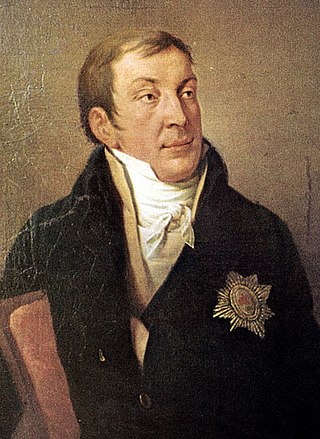
Karl Alois, Prince Lichnowsky was the second Prince Lichnowsky and a chamberlain at the Imperial Austrian court. He is remembered for his patronage of music and his relationships with Wolfgang Amadeus Mozart and Ludwig van Beethoven.

The House of Fürstenberg is the name of an old and influential Swabian noble house in Germany, based primarily in what is today southern Baden-Württemberg near the source of the Danube river. Numerous members of the family have risen to prominence over the centuries as soldiers, churchmen, diplomats, and academics. Sometimes the name is gallicized as de Furstenberg or anglicized as Furstenberg.
The House of Thun und Hohenstein, also known as Thun-Hohenstein, belonged to the historical Austrian and Bohemian nobility. There is one princely and several comital branches of the family. The princely branch of the family lived at Děčín in Bohemia for more than 200 years.

Philipp Matthäus Hahn was a German pastor, astronomer and inventor.
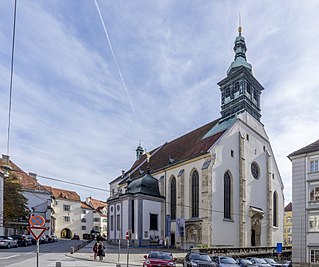
The Diocese of Graz-Seckau is a Latin Church diocese of the Catholic Church comprising the Austrian state of Styria. It is part of the Ecclesiastical Province of Salzburg.

Maximilian Karl, Prince of Löwenstein-Wertheim-Rochefort was an Austrian military officer and the first Prince of Löwenstein-Wertheim-Rochefort.
Dr. Anton Schelkopf was a German Psychologist doctor who also was among other works a Film Producer in the late 1940s and 1950s.
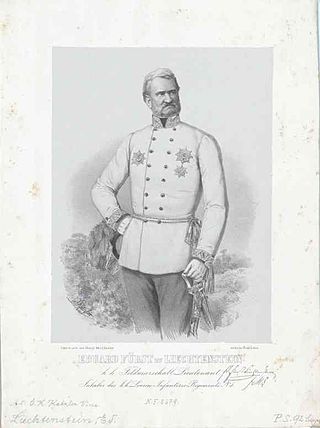
Prince Eduard Franz of Liechtenstein was a son of Johann I Joseph, Prince of Liechtenstein (1760–1836) and wife Landgravine Josepha of Fürstenberg-Weitra, nephew of Aloys I, brother of Aloys II and uncle of Johann II and Franz I.

Franz Joseph Maria Ludwig Anton Thassilo Prinz von Hohenzollern-Emden was a member of the Roman Catholic branch of the House of Hohenzollern. He was born as Prince Franz Joseph of Hohenzollern and adopted the surname Prinz von Hohenzollern-Emden in 1933.
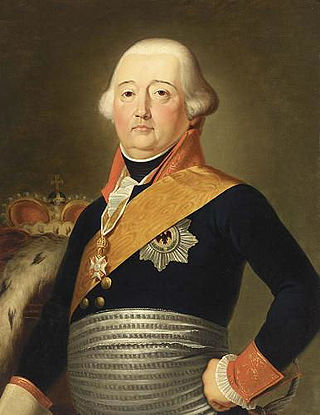
Hermann Friedrich Otto was the ruling Prince of Hohenzollern-Hechingen from 1798 until 1810.
Karl Friedrich was a member of the House of Hohenzollern and Prince of Hohenzollern-Sigmaringen, Lord of Haigerloch and Wehrstein from 1769 until his death.
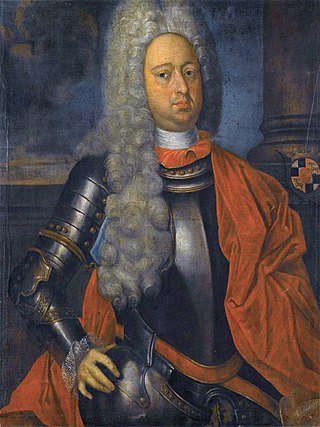
Friedrich Wilhelm of Hohenzollern-Hechingen was the fourth Prince of Hohenzollern-Hechingen and was also an imperial Field Marshal.
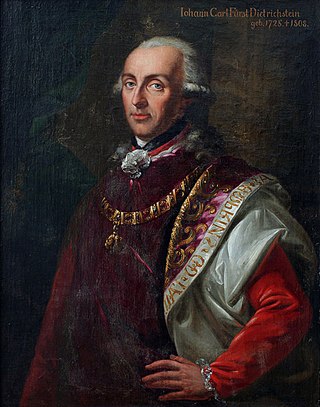
Karl Johann Baptist, Prince of Dietrichstein, was a German prince, member of the House of Dietrichstein, 7th Prince (Fürst) of Dietrichstein zu Nikolsburg, Princely Count of Tarasp, Baron (Freiherr) of Hollenburg, Finkenstein and Thalberg.

Franz Joseph, Prince of Dietrichstein, was a German prince, member of the House of Dietrichstein, Major general, 8th Prince (Fürst) of Dietrichstein zu Nikolsburg, Count of Proskau-Leslie, Baron (Freiherr) of Hollenburg, Finkenstein and Thalberg.

Moritz, Prince of Dietrichstein, was a German prince, member of the House of Dietrichstein, 10th and last Prince (Fürst) of Dietrichstein zu Nikolsburg, Count of Proskau-Leslie, Baron (Freiherr) of Hollenburg, Finkenstein and Thalberg.
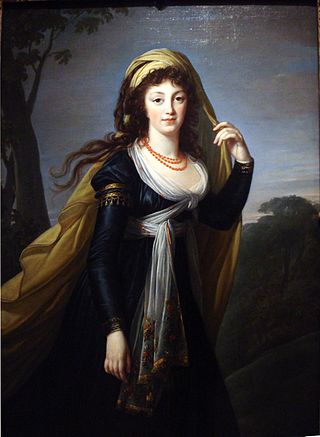
Theresia of Dietrichstein, was a German noblewoman; a member of the House of Dietrichstein and by her two marriages member of the House of Kinsky and member of the House of Mervedlt.
Theresia Anna Maria von Brühl, Gräfin von Thun und Hohenstein (1784–1844) was a German noblewoman and pastellist.
This page is based on this
Wikipedia article Text is available under the
CC BY-SA 4.0 license; additional terms may apply.
Images, videos and audio are available under their respective licenses.













